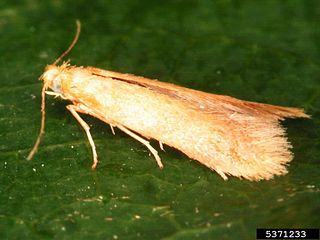
Lepidoptera is an order of insects that includes butterflies and moths. About 180,000 species of the Lepidoptera are described, in 126 families and 46 superfamilies, 10 percent of the total described species of living organisms. It is one of the most widespread and widely recognizable insect orders in the world. The Lepidoptera show many variations of the basic body structure that have evolved to gain advantages in lifestyle and distribution. Recent estimates suggest the order may have more species than earlier thought, and is among the four most speciose orders, along with the Hymenoptera, Diptera, and Coleoptera.

Moths are a paraphyletic group of insects that includes all members of the order Lepidoptera that are not butterflies, with moths making up the vast majority of the order. There are thought to be approximately 160,000 species of moth, many of which have yet to be described. Most species of moth are nocturnal, but there are also crepuscular and diurnal species.

The Arctiinae are a large and diverse subfamily of moths, with around 11,000 species found all over the world, including 6,000 neotropical species. This group includes the groups commonly known as tiger moths, which usually have bright colours, footmen, which are usually much drabber, lichen moths, and wasp moths. Many species have "hairy" caterpillars that are popularly known as woolly bears or woolly worms. The scientific name of this subfamily refers to this hairiness. Some species within the Arctiinae have the word tussock in their common name due to people misidentifying them as members of the Lymantriinae based on the characteristics of the larvae.

The Pyralidae, commonly called pyralid moths, snout moths or grass moths, are a family of Lepidoptera in the ditrysian superfamily Pyraloidea. In many classifications, the grass moths (Crambidae) are included in the Pyralidae as a subfamily, making the combined group one of the largest families in the Lepidoptera. The latest review by Eugene G. Munroe and Maria Alma Solis, in Kristensen (1999) retains the Crambidae as a full family of Pyraloidea.

Tischerioidea is the superfamily of "trumpet" leaf miner moths. The superfamily contains just one family, Tischeriidae, and traditionally one genus, Tischeria, but currently three genera are recognised, widespread across the world including South America, except for Australasia. This is one candidate as the sister group of the bulk of Lepidoptera, the Ditrysia, and they have a monotrysian type of female reproductive system. These small moths are leaf-miners in the caterpillar stage, feeding mainly on Fagaceae, Asteraceae, and Malvaceae (Astrotischeria), and some also on Rhamnaceae, Tiliaceae, and Rosaceae.

Schinia, commonly called flower moths, is a large genus of moths belonging to the family Noctuidae. The genus has a Holarctic distribution with the vast majority of species being found in North America, many with a very restricted range and larval food plant.

Astrotischeria is a genus of moths in the family Tischeriidae. It was described by Puplesis and Diškus in 2003.
Astrotischeria scalesiaella is a moth of the family Tischeriidae. It was described by Bernard Landry in 2004. It is found on the Galápagos Islands.
Astrotischeria ambrosiaeella is a moth of the family Tischeriidae. It was described by Vactor Tousey Chambers in 1875. It is found in North America, including California, Florida, Louisiana, Ohio and Texas.

Astrotischeria heliopsisella is a moth of the family Tischeriidae. It was described by Vactor Tousey Chambers in 1875. It is found in North America, including Illinois, Missouri and Ohio.

Astrotischeria astericola is a moth of the family Tischeriidae. It was originally described by Annette Frances Braun as Tischeria astericola in 1972. It is found in eastern North American woodlands.
Astrotischeria marginata is a moth of the family Tischeriidae. It was described by Annette Frances Braun in 1972. It is found in North America.
Astrotischeria occidentalis is a moth of the family Tischeriidae. It was described by Annette Frances Braun in 1972. It is found in North America.
Astrotischeria omissa is a moth of the family Tischeriidae. It was described by Annette Frances Braun in 1927. It is found in North America, including Arizona, California and New Mexico.
Astrotischeria pallidipennella is a moth of the family Tischeriidae. It was described by Annette Frances Braun in 1972. It is found in North America.
Astrotischeria helianthi is a moth of the family Tischeriidae. It was described by Frey and Boll in 1878. It is found in North America, including Missouri and Ohio.
Astrotischeria heteroterae is a moth of the family Tischeriidae. It was described by Frey and Boll in 1878. It is found in North America.

A MONA number, or Hodges number after Ronald W. Hodges, is part of a numbering system for North American moths found north of Mexico in the Continental United States and Canada, as well as the island of Greenland. Introduced in 1983 by Hodges through the publication of Check List of the Lepidoptera of America North of Mexico, the system began an ongoing numeration process in order to compile a list of the over 12,000 moths of North America north of Mexico. The system numbers moths within the same family close together for identification purposes. For example, the species Epimartyria auricrinella begins the numbering system at 0001 while Epimartyria pardella is numbered 0002.









